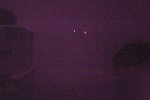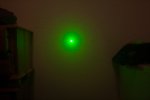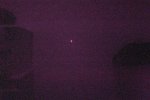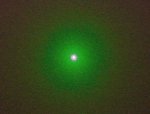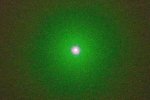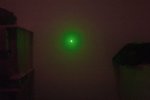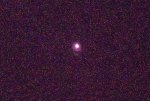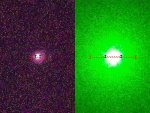grainde
0
- Joined
- Jan 29, 2012
- Messages
- 3,164
- Points
- 113
Just thought Id make a quick post about IR from 532 pens and lasers.
Most people seem to say that yes the IR is dangerous, but its not really too much of an issue as it is not collimated. Well I decided to take some pics to find out whether the IR was indeed collimated and focused with the 532.
In my recent review on a 301 laser I mentioned the IR component, which was basically all 1064 nm light. I also did a mini review for Kommed some time back for one of his ebay pens. Below are the graphs of the two lasers each with an IR filter:
532 ebay pen - Output 44 mW so 21 mW IR

301 laser - Output 91 mW so 19 mW IR

For the pictures I used my old canon 20D with a 10-22 EFS lens and a 77 mm B+W IR 093 filter. This filter blocks 100% of all visible light, but allows approx 15 % transmission at 810 nm and over 90 % above 1000 nm. Distance from camera to wall 1.5 m.
The first pic is actually composed of 3 different 532 lasers, but one (the control laser - Global Laser Firefly) is IR filtered, so you cant see it! (Order - Firefly : Kommed pen : 301 laser). Note: The firefly control laser confirms that 532 is completely blocked by the filter, this means the dots are purely IR.
(Order - Firefly : Kommed pen : 301 laser). Note: The firefly control laser confirms that 532 is completely blocked by the filter, this means the dots are purely IR.

The second and third photos are without and with the filter again on the 301 laser.


Finally I used photoshop to superimpose the photos and reduced the opacity of the 532 picture to show the IR dot beneath.

Zoomed in...


Conclusion: Yes the IR is extremely well collimated!! Please take care... :beer:
Most people seem to say that yes the IR is dangerous, but its not really too much of an issue as it is not collimated. Well I decided to take some pics to find out whether the IR was indeed collimated and focused with the 532.
In my recent review on a 301 laser I mentioned the IR component, which was basically all 1064 nm light. I also did a mini review for Kommed some time back for one of his ebay pens. Below are the graphs of the two lasers each with an IR filter:
532 ebay pen - Output 44 mW so 21 mW IR

301 laser - Output 91 mW so 19 mW IR

For the pictures I used my old canon 20D with a 10-22 EFS lens and a 77 mm B+W IR 093 filter. This filter blocks 100% of all visible light, but allows approx 15 % transmission at 810 nm and over 90 % above 1000 nm. Distance from camera to wall 1.5 m.
The first pic is actually composed of 3 different 532 lasers, but one (the control laser - Global Laser Firefly) is IR filtered, so you cant see it!
The second and third photos are without and with the filter again on the 301 laser.
Finally I used photoshop to superimpose the photos and reduced the opacity of the 532 picture to show the IR dot beneath.
Zoomed in...
Conclusion: Yes the IR is extremely well collimated!! Please take care... :beer:
Attachments
Last edited:


